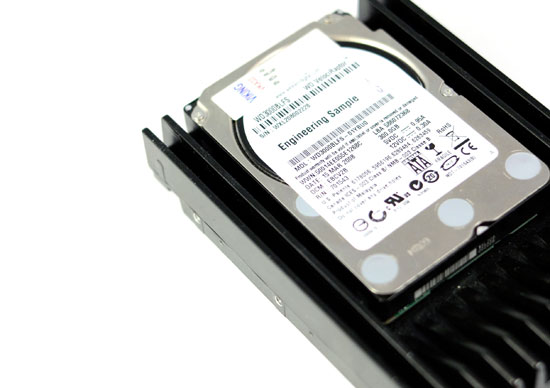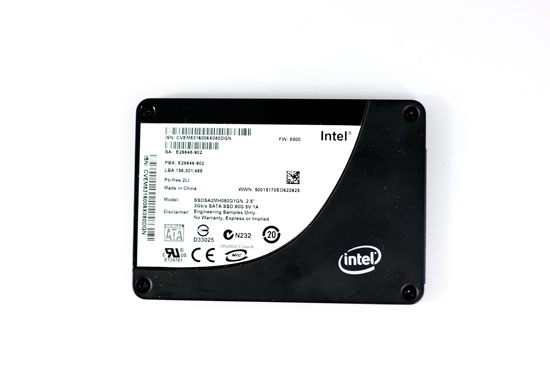The SSD Anthology: Understanding SSDs and New Drives from OCZ
by Anand Lal Shimpi on March 18, 2009 12:00 AM EST- Posted in
- Storage
Why You Should Want an SSD
For the past several months I’ve been calling SSDs the single most noticeable upgrade you can do to your computer. Whether desktop or laptop, stick a good SSD in there and you’ll notice the difference.
I’m always angered by the demos in any Steve Jobs keynote. Not because the demos themselves are somehow bad, but because Jobs always has a perfectly clean machine to run the demos on - and multiple machines at that. Anyone who has built a computer before knows the glory of a freshly installed system; everything just pops up on your screen. Applications, windows, everything - the system is just snappy.
Of course once you start installing more applications and have more things running in the background, your system stops being so snappy and you tend to just be thankful when it doesn’t crash.
A big part of the problem is that once you have more installed on your system, there are more applications sending read/write requests to your IO subsystem. While our CPUs and GPUs thrive on being fed massive amounts of data in parallel, our hard drives aren’t so appreciative of our multitasking demands. And this is where SSDs truly shine.
Before we go too far down the rabbit hole I want to share a few numbers with you.
This is Western Digital’s VelociRaptor. It’s a 300GB drive that spins its platters at 10,000RPM and is widely considered the world’s fastest consumer desktop hard drive.

The 300GB VelociRaptor costs about $0.77 per GB.
This is the Intel X25-M. The Conroe of the SSD world, the drive I reviewed last year. It costs about $4.29 per GB; that’s over 5x the VelociRaptor’s cost per GB.

The VelociRaptor is the dominant force in the consumer HDD industry and the X25-M is the svelte bullfighter of the SSD world.
Whenever anyone mentions a more affordable SSD you always get several detractors saying that you could easily buy 2 VelociRaptors for the same price. Allow me to show you one table that should change your opinion.
This is the Average Read Access test from Lavalys’ Everest Disk benchmark. The test simply writes a bunch of files at random places on the disk and measures how long it takes to access the files.
Measuring random access is very important because that’s what generally happens when you go to run an application while doing other things on your computer. It’s random access that feels the slowest on your machine.
| Random Read Latency in ms | |
| Intel X25-M | 0.11 ms |
| Western Digital VelociRaptor | 6.83 ms |
The world’s fastest consumer desktop hard drive, Western Digital’s 300GB VelociRaptor can access a random file somewhere on its platters in about 6.83ms; that’s pretty quick. Most hard drives will take closer to 8 or 9ms in this test. The Intel X25-M however? 0.11ms. The fastest SSDs can find the data you’re looking for in around 0.1ms. That’s an order of magnitude faster than the fastest hard drive on the market today.
The table is even more impressive when you realize that wherever the data is on your SSD, the read (and write) latency is the same. While HDDs are fastest when the data you want is in the vicinity of the read/write heads, all parts of a SSD are accessed the same way. If you want 4KB of data, regardless of where it is, you’ll get to it at the same speed from a SSD.
The table below looks at sequential read, sequential write and random write performance of these two kings of their respective castles. The speeds are in MB/s.
| Sequential Read (2MB Block) | Sequential Write (2MB Block) | Random Write (4KB Block) | |
| Intel X25-M | 230 MB/s | 71 MB/s | 23 MB/s |
| Western Digital VelociRaptor | 118 MB/s | 119 MB/s | 1.6 MB/s |
If you’re curious, these numbers are best case scenario for the VelociRaptor and worst case scenario for the X25-M (I’ll explain what that means later in the article). While the VelociRaptor is faster in the large block sequential writes look at the sequential read and random write performance. The X25-M destroys the VelociRaptor in sequential reads and is an order of magnitude greater in random write performance. If you’re curious, it’s the random write performance that you’re most likely to notice and that’s where a good SSD can really shine; you write 4KB files far more often than you do 2MB files while using your machine.
If the table above doesn’t convince you, let me share one more datapoint with you. Ever play World of Warcraft? What we’re looking at here is the amount of time it takes to get from the character selection screen into a realm with everything loaded. This is on a fully configured system with around 70GB of applications and data as well as real time anti-virus scanning going on in the background on every accessed file.
| WoW Enter Realm Time in Seconds | |
| Intel X25-M | 4.85 s |
| Western Digital VelociRaptor | 12.5 s |
The world’s fastest hard drive gets us into the game in 12.5 seconds. The Intel X25-M does it in under 5.
SSDs make Vista usable. It doesn’t matter how much background crunching the OS is doing, every application and game launches as if it were the only thing running on the machine. Everything launches quickly. Much faster than on a conventional hard drive. If you have the ability, try using your system with a SSD for a day then go back to your old hard drive; if that test doesn’t convince you, nothing will.
That’s just a small taste of why you’d want an SSD, now let’s get back to finding a good one.










250 Comments
View All Comments
sbuckler - Wednesday, March 18, 2009 - link
Depends on how smart the controller is? Shuffling around the data now and again in the background would make sense.Frallan - Wednesday, March 18, 2009 - link
@AT
This is why i come to AT to read up on the developments.
@OCZ
Well played :0)
The ruler of the roost are the Intels however I will be able to afford one of those when there are cows enjoying themselfs by dancing on the moon. My next upgrade will be a Vertex - not only bc its Valu for money but equally much bc. OCZ obviously takes care of thier customers and listens to reason.
pmonti80 - Wednesday, March 18, 2009 - link
This is the kind of article that makes me come back here.nowayout99 - Wednesday, March 18, 2009 - link
OCZ, you should listen to Uncle Anand. ;) Hopefully Mr. Petersen understands that it's tough love.And the final product seems perfectly cool -- great performance at a better price than Intel. It's the first SSD I'd be able to reasonably consider.
SOLIDNecro - Wednesday, March 18, 2009 - link
Thx for this article Anand, I have been in a hotly contested debate over OCZ vs Samsung with my "Asperger Enhanced" nemisis/close friend...(In all fairness, I should mention I use the BiPolar SSE instruction set myself)
He was only looking at Samsung, I said he should look into what OCZ has now.
His reply was "I don't know them, and don't want to be disapointed"
(Long story behind that...He's from the Server/Workstain/HPC crowd, I am from the hardcore OC/Gamer/Desktop group, so he is not familiar with OCZ)
Looks like the Samsung (And alot of others) has "Issues" with performance degrading over time that are somewhat solved by Intel and OCZ (Plus maybe a few other companies that use the Rev B JMicron controller on there low cost SSD's)
I agree the OCZ Vertex offers the best bang for low buck SSD today, and I am tempted to grab one. But a year from now, anyone that bought a current gen MLC SSD will be saying "I coulda had a V-8" if that TRIM technology does what it promises!!!
James5mith - Wednesday, March 18, 2009 - link
As people continue to try and push the envelope of storage performance in a variety of ways, and as 6gbps SATA becomes available, the performance of SSD's will only go up.As always, I wanted to say thanks for the great article and keep them coming. It's the only way the rest of us can keep pace with what's happening out there in the world of performance storage.
vailr - Wednesday, March 18, 2009 - link
Is there any benefit in using 2 SSD's in a Raid 0 configuration?And: any differences between motherboard Intel Raid vs. a Raid controller card from Areca, for example. Also: can the "Trim" command work while in Raid mode? Probably not, I'm guessing...
7Enigma - Thursday, March 19, 2009 - link
Raid0 is really the holy grail for SSD's. The low risk of failure of SSD's which normally makes Raid0 with typical mechanical HD's more dangerous is very appealing. My personal storage-size goal is ~120-160gigs. Once they reach that size for under $300 I think I'm going to jump in. But I'm more likely to grab 2 60's or 2 80's and Raid0 them than get a single large SSD. The added performance will outweigh the higher power draw of 2 drives, and should make them extremely competitive with Intel's offerings (or whatever holds the crown at the time).I figure it will be about a year or so until the prices are in that range, as 2 60gig Vertex drives will currently run you about $400 after rebate.
I can't wait to jump on that upgrade and will then put my current 250gig mechanical drive as the storage drive (I don't use a ton of space in general as I have a 320gig external backup).
Rasterman - Thursday, March 19, 2009 - link
The problem with doing that is if you want to move your drives to another system they won't work, so upgrading is a pain. You could image them I guess, but plugging one drive in is much simpler. I had an older XP install that made it through 3-4 different systems.I would also question real world results, if you're going at 250MB/s or 500MB/s its not even going to be noticeable unless you are doing some massive video editing or some other huge file operations, and as Anand says, SSDs don't fill this role right now as they are super expensive per GB. So if you really are editing video a lot, you are going to need a hell of a lot more space than SSDs can offer you.
Gasaraki88 - Friday, March 20, 2009 - link
RAID is a universal standard so if you take two RAID0 drives out and move them to another computer with a RAID controller, it SHOULD just work if the original RAID was doing it correctly.